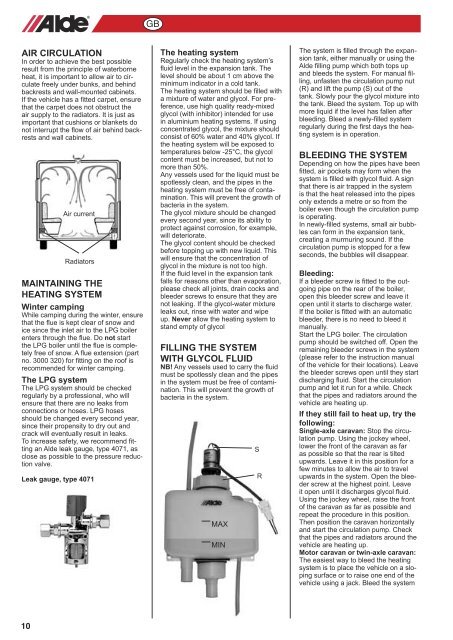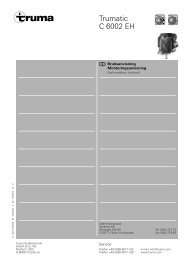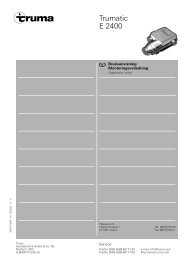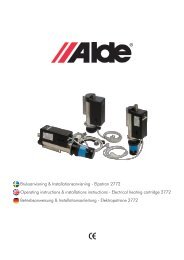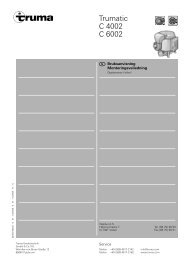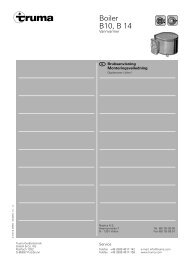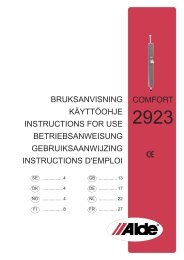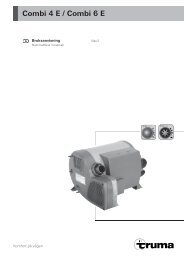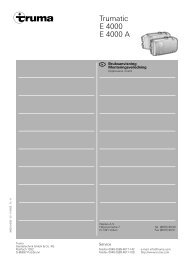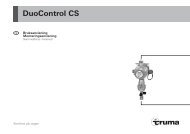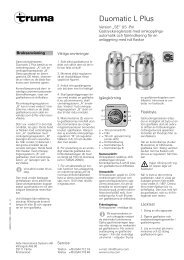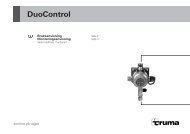V-3000 06-3, Bruksanvisning, Rev 729.indd - Neptus AS
V-3000 06-3, Bruksanvisning, Rev 729.indd - Neptus AS
V-3000 06-3, Bruksanvisning, Rev 729.indd - Neptus AS
Sie wollen auch ein ePaper? Erhöhen Sie die Reichweite Ihrer Titel.
YUMPU macht aus Druck-PDFs automatisch weboptimierte ePaper, die Google liebt.
GB<br />
AIR CIRCULATION<br />
In order to achieve the best possible<br />
result from the principle of waterborne<br />
heat, it is important to allow air to circulate<br />
freely under bunks, and behind<br />
backrests and wall-mounted cabinets.<br />
If the vehicle has a fitted carpet, ensure<br />
that the carpet does not obstruct the<br />
air supply to the radiators. It is just as<br />
important that cushions or blankets do<br />
not interrupt the flow of air behind backrests<br />
and wall cabinets.<br />
Air current<br />
Radiators<br />
MAINTAINING THE<br />
HEATING SYSTEM<br />
Winter camping<br />
While camping during the winter, ensure<br />
that the flue is kept clear of snow and<br />
ice since the inlet air to the LPG boiler<br />
enters through the flue. Do not start<br />
the LPG boiler until the flue is completely<br />
free of snow. A flue extension (part<br />
no. <strong>3000</strong> 320) for fitting on the roof is<br />
recommended for winter camping.<br />
The LPG system<br />
The LPG system should be checked<br />
regularly by a professional, who will<br />
ensure that there are no leaks from<br />
connections or hoses. LPG hoses<br />
should be changed every second year,<br />
since their propensity to dry out and<br />
crack will eventually result in leaks.<br />
To increase safety, we recommend fitting<br />
an Alde leak gauge, type 4071, as<br />
close as possible to the pressure reduction<br />
valve.<br />
Leak gauge, type 4071<br />
The heating system<br />
Regularly check the heating system’s<br />
fluid level in the expansion tank. The<br />
level should be about 1 cm above the<br />
minimum indicator in a cold tank.<br />
The heating system should be filled with<br />
a mixture of water and glycol. For preference,<br />
use high quality ready-mixed<br />
glycol (with inhibitor) intended for use<br />
in aluminium heating systems. If using<br />
concentrated glycol, the mixture should<br />
consist of 60% water and 40% glycol. If<br />
the heating system will be exposed to<br />
temperatures below -25°C, the glycol<br />
content must be increased, but not to<br />
more than 50%.<br />
Any vessels used for the liquid must be<br />
spotlessly clean, and the pipes in the<br />
heating system must be free of contamination.<br />
This will prevent the growth of<br />
bacteria in the system.<br />
The glycol mixture should be changed<br />
every second year, since its ability to<br />
protect against corrosion, for example,<br />
will deteriorate.<br />
The glycol content should be checked<br />
before topping up with new liquid. This<br />
will ensure that the concentration of<br />
glycol in the mixture is not too high.<br />
If the fluid level in the expansion tank<br />
falls for reasons other than evaporation,<br />
please check all joints, drain cocks and<br />
bleeder screws to ensure that they are<br />
not leaking. If the glycol-water mixture<br />
leaks out, rinse with water and wipe<br />
up. Never allow the heating system to<br />
stand empty of glycol<br />
FILLING THE SYSTEM<br />
WITH GLYCOL FLUID<br />
NB! Any vessels used to carry the fluid<br />
must be spotlessly clean and the pipes<br />
in the system must be free of contamination.<br />
This will prevent the growth of<br />
bacteria in the system.<br />
MAX<br />
MIN<br />
S<br />
R<br />
The system is filled through the expansion<br />
tank, either manually or using the<br />
Alde filling pump which both tops up<br />
and bleeds the system. For manual filling,<br />
unfasten the circulation pump nut<br />
(R) and lift the pump (S) out of the<br />
tank. Slowly pour the glycol mixture into<br />
the tank. Bleed the system. Top up with<br />
more liquid if the level has fallen after<br />
bleeding. Bleed a newly-filled system<br />
regularly during the first days the heating<br />
system is in operation.<br />
BLEEDING THE SYSTEM<br />
Depending on how the pipes have been<br />
fitted, air pockets may form when the<br />
system is filled with glycol fluid. A sign<br />
that there is air trapped in the system<br />
is that the heat released into the pipes<br />
only extends a metre or so from the<br />
boiler even though the circulation pump<br />
is operating.<br />
In newly-filled systems, small air bubbles<br />
can form in the expansion tank,<br />
creating a murmuring sound. If the<br />
circulation pump is stopped for a few<br />
seconds, the bubbles will disappear.<br />
Bleeding:<br />
If a bleeder screw is fitted to the outgoing<br />
pipe on the rear of the boiler,<br />
open this bleeder screw and leave it<br />
open until it starts to discharge water.<br />
If the boiler is fitted with an automatic<br />
bleeder, there is no need to bleed it<br />
manually.<br />
Start the LPG boiler. The circulation<br />
pump should be switched off. Open the<br />
remaining bleeder screws in the system<br />
(please refer to the instruction manual<br />
of the vehicle for their locations). Leave<br />
the bleeder screws open until they start<br />
discharging fluid. Start the circulation<br />
pump and let it run for a while. Check<br />
that the pipes and radiators around the<br />
vehicle are heating up.<br />
If they still fail to heat up, try the<br />
following:<br />
Single-axle caravan: Stop the circulation<br />
pump. Using the jockey wheel,<br />
lower the front of the caravan as far<br />
as possible so that the rear is tilted<br />
upwards. Leave it in this position for a<br />
few minutes to allow the air to travel<br />
upwards in the system. Open the bleeder<br />
screw at the highest point. Leave<br />
it open until it discharges glycol fluid.<br />
Using the jockey wheel, raise the front<br />
of the caravan as far as possible and<br />
repeat the procedure in this position.<br />
Then position the caravan horizontally<br />
and start the circulation pump. Check<br />
that the pipes and radiators around the<br />
vehicle are heating up.<br />
Motor caravan or twin-axle caravan:<br />
The easiest way to bleed the heating<br />
system is to place the vehicle on a sloping<br />
surface or to raise one end of the<br />
vehicle using a jack. Bleed the system<br />
10


